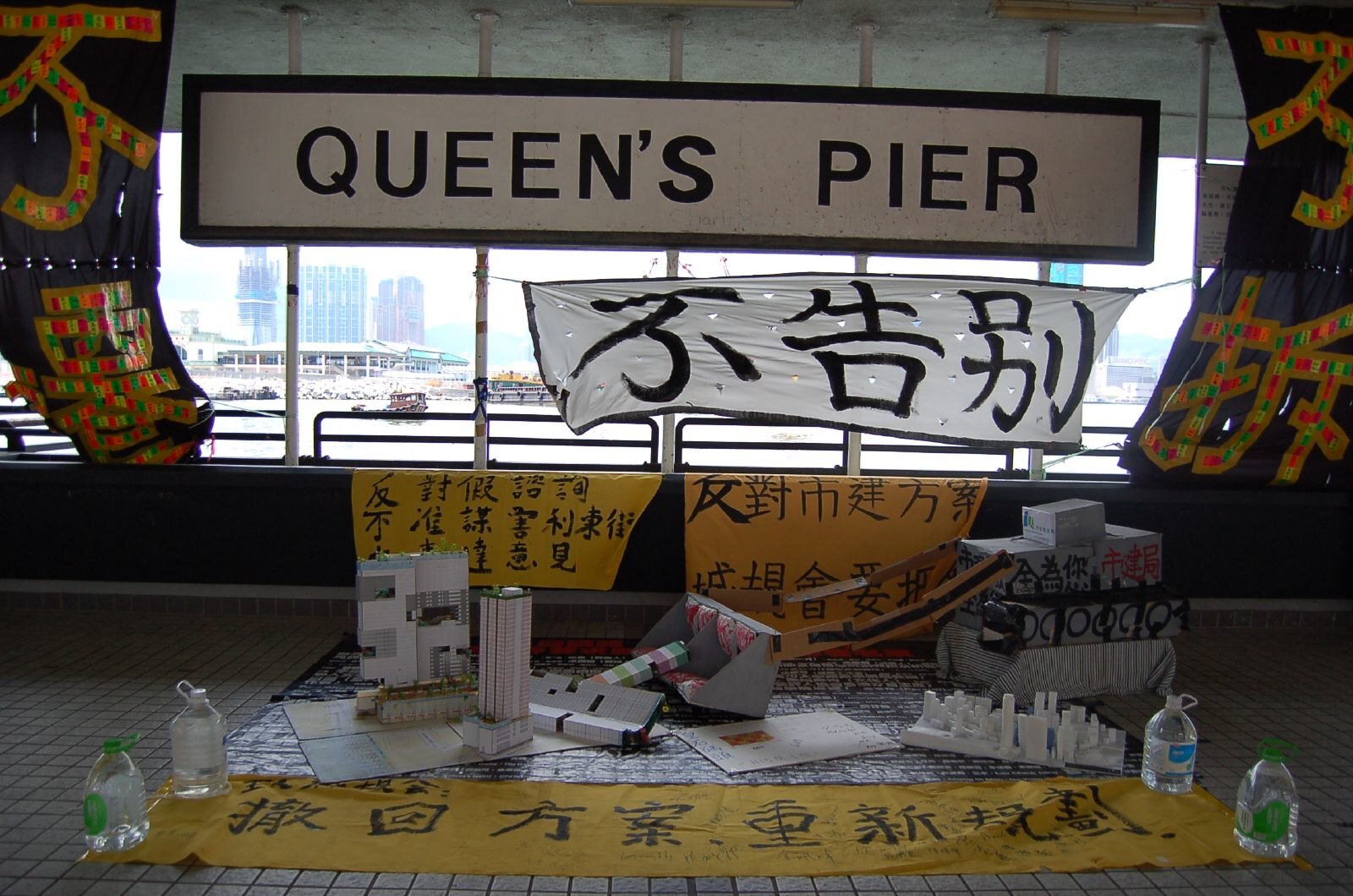Queen's Pier
Emergence of Contestation: 2007
The Queen's Pier in Hong Kong can function as a case study of the degree to which (formerly) colonial spaces continue to shape people's relationships to their colonial past and their own identitities even in the post-colonial period, through their spatial design intertwined with colonial education which generate lasting control systems impacting both body and mind.
Tracing the inveterate (post-)colonial controls: Queen's Pier in Hong Kong and the 'Cape No. 7' in Hengchun, Taiwan - Liza Wing Man Kam
Puppet Emperor Palace Museum
Emergence of Contestation: 1984
The Puppet Emperor Palace, dedicated to China's emperor Puyi, is at present designed to serve as a "site of memory" for the emperor's life journey from the throne to becoming an ordinary citizen of the newly formed Chinese state, as well as a symbol of China's successfull wartime struggle against the Japanese rule (specifically Japan's puppet government in Manchukuo). However, the site itself did not serve as the stage for most of Puyi's conversion, nor did it figure prominently in the Chinese resistance, which seemingly somewhat undermines its claim to the "site of memory" title. A consideration of the actual history of active Japanese governance associated with the site (as opposed to the "victim narrative" carefully constructed by the CCP) could restore this title to the museum, but would require a departure from the official Party narrative aimed at centering national legitimacy.
Beyond a "Site of Memory": The Puppet Emperor Palace Museum - Emily Matson
Lin Zhao Tomb
Emergence of Contestation: 2013
Lin Zhao (Chinese: 林昭; January 23, 1932 – April 29, 1968), born Peng Lingzhao (彭令昭), was a prominent dissident who was imprisoned and later executed by the People's Republic of China during the Cultural Revolution for her criticism of Mao Zedong's policies. On the date of her death (April 29), memorial gatherings on the site of her tomb was interrupted by the authority with conflicts.
June 4th Museum (Tiananmen Incident)
Emergence of Contestation: 2019
The June 4th Museum in Hong Kong commemorates the student democratization movement and the Tiananmen Incident in 1989 in Beijing. There has been several instances that the museum was broken into by the unknown forces and protested against by the pro-Beijing groups in Hong Kong, who claimed that the museum is distorting history. In mainland China the Tiananmen Incident is identified as student riot, which is counter-revolutionary, whereas elsewhere the Incident is widely seen as democratization movement that was repressed by the authorities.
Jiabiangou Labor Camp Sites
Emergence of Contestation: 2013, 2014
Jiabiangou Labor Camp (Chinese: 夹边沟; pinyin: Jiābiāngōu) is a former farm labor camp (laogai) located in Jiuquan in the northwestern desert region of Gansu Province. The camp was in use during the Anti-Rightist Campaign in the years from 1957 to 1961. During its operation, it held approximately 3,000 political prisoners, of whom about 2,500 died at Jiabianguo, mostly of starvation. Remains of the camp, including the graveyards, are unmaintained and heavily guarded to prevent people from visiting. In November 2013, a new monument erected by families and social workers was quickly destroyed by local authorities. Ai Xiaoming, a professor of Sun Yat-sen University, was briefly detained before released and prevented from photographing the site in May 2014.
Hengchun
Emergence of Contestation: 1940s
Hengchun in Taiwan can function as a case study of the degree to which (formerly) colonial spaces continue to shape people's relationships to their colonial past and their own identitities even in the post-colonial period, through their spatial design intertwined with colonial education which generate lasting control systems impacting both body and mind.
Tracing the inveterate (post-)colonial controls: Queen's Pier in Hong Kong and the 'Cape No. 7' in Hengchun, Taiwan - Liza Wing Man Kam
Okawa Elementary School
Emergence of Contestation: 2011
In the wake of the March 2011 disasters in Tohoku, several remaining ruins have become sites of negative heritage. This site - at which the failure to manage the evacuation of pupils led to tragedy - has been subject of a debate between survivors and the Japanese government, with the former wanting to preserve the school buildings, and the latter seeking to demolish them.
Framing Negative Heritage in Disaster Risk Education: School Memorials After 3.11 - Julia Gerster, Flavia Fulco
Ainu Remains
Emergence of Contestation: 1869
The Ainu human remains stolen from Hokkaido gravesites for scientific purposes in the period of the Japanese colonisation of Hokkaido are presently still housed in museum collections across the globe, provoking protest from Ainu activists who demand their return. The remains themselves have become sites of memory through which Japanese colonial amnesia is challenged.
Stolen Ainu Remains as Sites of Memory - Michael Roellinghoff
Tsugaru Storytelling
The "Wa no mukashi-ko" storytellers from the Tsugaru region in Aomori construct heritage through inherited oral folklore recited in dialect, which they adapt and pass on to the local people. This vernacular tradition stands in contrast with the hegemonic discourse of authenticity linked to the region through narratives manufactured in the country's centre in Tokyo.
The Inheritance of Voice, Intentionality, and Provincial Japan: Storytelling in Tsugaru - Joshua Lee Solomon
Arahama Elementary School
Emergence of Contestation: 2011
In the wake of the March 2011 disasters in Tohoku, several remaining ruins have become sites of negative heritage. This site - an example of a successful evacuation - is being preserved as a monument to the importance of disaster preparation (BOSAI).
Framing Negative Heritage in Disaster Risk Education: School Memorials After 3.11 - Julia Gerster, Flavia Fulco


















